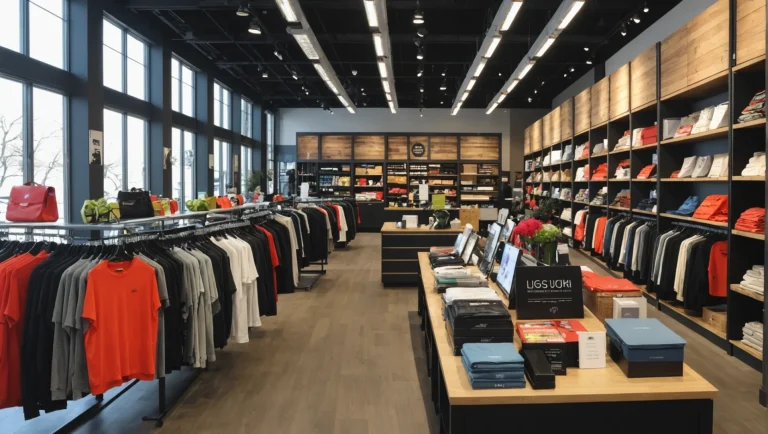Tired of seeing your retail store sales stagnate?
Get ready to shake up your retail merchandising strategy with data-driven insights. We’re diving into 15 retail merchandising strategies that are packed with tactics to boost your sales. You’ll learn about tech tools that optimize stock and sales, and visual merchandising that draws customers in.
This isn’t just theory; we include real-world examples and practical steps you can take. By the end, you’ll understand the power of using data in merchandising.
Metrobi drivers are rated 4.97/5
Trusted by local businesses for:
- Background-checked professionals
- Specialized in business deliveries
- Same drivers for consistency
- 4.97/5 average delivery rating
Retail Merchandising Strategies: What is Retail Merchandising?
Retail merchandising promotes products to boost sales. It covers store layout, product presentation, and pricing.
Goals include attracting customers, maximizing sales, and ensuring inventory matches customer needs.
Examples of Retail Merchandising
Retail merchandising is visible in stores worldwide, from high-end boutiques to local supermarkets. For instance, Apple stores emphasize a sleek, minimalistic product presentation, which aligns with their brand identity and attracts tech-savvy crowds. Their store layout encourages hands-on interaction, which enhances customer engagement and drives sales. Similarly, grocery chains like Trader Joe’s strategically move retail displays that position popular items at eye level and near the entrance to capture immediate customer interest and increase purchase likelihood. Explore how mastering the essentials of merchandising in retail can transform the shopping experience and significantly boost your store’s revenue.
A key strategy for boosting sales is implementing seasonal, in-store displays throughout. Retail chains like Macy’s change store themes around holidays, installing themed displays that entice customers to engage with new products or sales linked to the season. Through regular alteration of these displays, stores keep the shopping experience fresh, attracting repeat customers. Unlock the potential of your small business by adopting seasonal merchandising strategies that cater to changing consumer interests and promote frequent visits.
Types of Merchandising Tools
Merchandising tools can significantly improve store presentation and enhance sales. These store merchandising tools range from eye-catching displays to advanced tech solutions.
Displays, Signage, and Tech
Displays and signage are the backbone of visual merchandising. Well-thought-out displays can spotlight products and boost impulse purchases. Effective signage guides customers through the store and highlights promotions or new arrivals. Many brick-and-mortar stores can now incorporate technology, such as digital signs, to provide dynamic, engaging content.
Technology also plays a critical role in both merchandise planning and optimizing store operations. Data analytics and artificial intelligence (AI) tools help monitor sales patterns and manage inventory. For instance, Target uses predictive analytics to determine what products to promote in each store, aligning stock with local preferences and trends.
Type 1: Visual Merchandising
Visual merchandising sets the stage for physical and digital stores for a welcoming shopping experience. It’s not just about arranging products but about creating a space that reflects the brand and captivates customers.
Role in Creating Inviting Environments
Visual merchandising creates an inviting atmosphere in online stores by using color, lighting, and space effectively. Stores like Anthropologie are known for their artistic window displays that tell a story, drawing customers in. By utilizing warm lighting and background music, they create an ambiance that encourages browsing and extends shopping time.
Examples of Effective Visual Setups
Visual setups should align with the brick-and-mortar brand’s identity. A case in point is Tory Burch, where stores are designed to reflect the brand’s personality, using sleek and boutique-styled arrangements. This configuration not only makes products accessible but also elevates the shopping experience, compelling customers to explore more.
Type 2: Tech-based Merchandising
Tech-based merchandising leverages advanced tools for a competitive edge. It’s about using data and technology to make informed decisions that enhance sales and improve customer satisfaction.
Use of Data Analytics, AI, and Software
Data analytics tools analyze customer behavior and preferences. Retailers like Amazon use AI to offer personalized recommendations, driving conversions. Software solutions optimize stock levels, reducing waste and ensuring products are always available.
Benefits of Data-Driven Merchandising Techniques
Benefit 1: Improved Customer Insights
Understanding customer behavior is key in retail. Data drives this understanding. When you look at data, you see patterns in customer preferences. When a shopper picks a product, they’re leaving a clue. Once a store gathers these clues, they can build a profile of what a typical customer desires. For example, if many customers are buying eco-friendly products, it may signal a shift in consumer behavior.
Analyzing these patterns gives retailers a goldmine of insights. They can see what products fly off the shelves and which ones languish. This understanding helps retailers tailor their offerings to meet demand effectively. Knowing what the customer wants before they ask for it enhances the shopping experience. As consumers see that the retailer anticipates their needs, brand recognition and loyalty strengthen.
Benefit 2: Increased Sales Efficiency
Data analysis takes away the guesswork in stock management. Knowing when to order and in what quantity can reduce overstocking and understocking. These situations often lead to lost sales or excess inventory that ties up capital. Businesses faced with overstock often resort to discounts to clear out products, which can lead to decreased margins. Understocking, on the other hand, frustrates customers and drives them to competitors.
Advanced data techniques help optimize stock levels. Predictive analytics provides retailers with the tools to forecast demand accurately. Retailers can integrate AI-driven systems, much like seen in tech companies such as Amazon, to streamline their inventory planning processes.
Pricing strategies can similarly benefit. Instead of blanket discounting, data helps to understand where to set prices to maintain a competitive edge while maximizing margins. Retailers can implement dynamic pricing models that adjust based on market trends and customer buying patterns.
Benefit 3: Enhanced Marketing Alignment
Data is not just a tool for product placement; it’s essential for crafting compelling marketing campaigns. By examining customer data, marketers can tailor their messaging to resonate more deeply with audience segments. Knowing a customer’s purchasing history allows for personalized promotions that touch on their interests.
This level of personalization means marketing resources are used more efficiently. Campaigns that are data-informed yield better returns on investment. Instead of casting a wide net, marketing becomes targeted, like a sharp spear. This not only saves money but also fosters stronger customer loyalty and relationships.
Benefit 4: Flexible and Adaptive Operations
The retail world is always changing. Seasonal trends, economic shifts, and competitor actions can influence sales patterns. Having the agility to adapt quickly to these changes is crucial. Data provides this flexibility. Real-time analysis allows for immediate operational adjustments, whether it’s launching a new product or adjusting to an unforeseen market trend.
Being able to pivot enhances a retailer’s resilience in volatile times. Systems like those employed by retail giants enable retailers to switch gears seamlessly, staying ahead of market disruptions. While some data-driven decisions may initially seem counterintuitive, they often lead to critical insights that support long-term growth.
Benefit 5: Predictive Market Trends
Historically, businesses relied on intuition to predict market trends. Data has changed the game. Predictive analytics identifies emerging market trends before they become mainstream, giving retailers a substantial edge over competitors. Early adopters are often able to lead the market, setting the pace for others to follow.
Retailers using data see these shifts and prepare accordingly. By anticipating what will be in demand, they can adjust their product lines and marketing campaigns, ensuring they meet customer expectations time after time. This predictive ability transforms data from a reactive tool to a proactive asset in a successful retail merchandising strategy.
How Sales Optimization in Retail Works
Step #1: Analyze Sales Data
Understanding sales optimization starts with analyzing sales data. Retailers must collect accurate data to identify patterns and trends. This lays the groundwork for informed decision-making. It goes beyond just gathering the numbers. Retailers need to know what these numbers mean. You should rely on data tracking systems. These systems help pinpoint problem areas. You’re not merely counting sales; you’re understanding why they happened. This differentiates reactive management from proactive planning.
Common methods for collecting sales data include point-of-sale systems and customer relationship management software. These tools offer not just raw data but insights into customer preferences and buying behaviors.
Step #2: Optimize Pricing
Optimizing pricing is the next logical step in sales optimization. Retailers often test different pricing strategies to find the sweet spot. Strategies may include competitive pricing, value-based pricing, or cost-plus pricing. Dynamic pricing is a powerful tool in today’s market. It adjusts prices based on current demand, competitor pricing, and even the time of day. This flexibility helps retailers maximize revenue without alienating customers.
Pricing isn’t just about being the cheapest; it’s about offering perceived value. As Zig Ziglar noted, “It’s easier to explain price once than to apologize for quality forever.” The aim is to align pricing with both business goals and customer expectations.
Step #3: Enhance Employee Training
Enhanced employee training is a critical yet sometimes overlooked component of sales optimization. Employees need comprehensive training on sales techniques and customer engagement. This isn’t just about closing a sale; it’s about understanding the product and making it relatable to customers. Tony Hsieh aptly says, “Your brand is not what you sell; it’s the experience you deliver.”
Training should cover various aspects, from understanding the benefits of products to learning how to handle objections and close sales. Employees should also be versed in upselling and cross-selling techniques. Invest in training programs and workshops to keep skills sharp and knowledge updated.
Step #4: Metric Tracking and Measurement
Accurate metric tracking is vital for sales optimization. Retailers should regularly measure key sales metrics like conversion rates, average transaction value, and customer acquisition costs. You can use technology to ease this process. Metrics allow retailers to gauge the success of various strategies and make improvements in real time. By having robust metrics in place, businesses can pivot strategies quickly as new insights arise.
Real-time data analysis holds significant potential. It enables immediate adjustments, whether restocking popular items or adjusting marketing tactics. Retailers using data-driven strategies have witnessed operational efficiencies, such as a 7-12% increase in topline revenue.
Step #5: Align Marketing Campaigns with Sales Goals
Aligning marketing campaigns with sales goals enhances both short-term and long-term retail success. A disjointed marketing and sales strategy can weaken a brand and confuse customers. You can create marketing campaigns that resonate with customer values and encourage them to take action. This alignment goes beyond just promotions; it’s strategic.
Campaigns should support specific sales objectives, like promoting particular products or improving customer lifetime value. You should utilize omnichannel marketing to reach customers where they are—both online and offline. This creates a seamless customer experience that bridges the gap between marketing and sales.
A holistic understanding of how sales optimization in retail functions can help boost sales effectively. Businesses that skillfully apply these techniques are poised to see significant improvements in store, better customer satisfaction, and long-term success.
Visual Merchandising Best Practices for Retailers
Practice 1: Use Themed Displays
Organize Products Around a Central Theme
You can create themed displays to engage customers. Consumers are more likely to purchase products that are part of a themed group. Group your items by a theme that relates to customers’ needs or the season. For example, during winter, a cozy theme with blankets, hot cocoa, and slippers can catch the eye. Arranging products this way encourages a deeper emotional connection with the consumer.
Rotate Themes to Keep Displays Fresh
Regularly change your displays. If a theme stays too long, customers may lose interest. It’s often helpful to align new themes with current trends or upcoming holidays. This can enhance the store atmosphere and capture customer attention, stimulating repeat visits.
Practice 2: Effective Signage
Use Clear and Informative Signs
Signage plays a crucial role in guiding customer decisions. Indicate key product features, prices, and benefits. The font should be easy to read, and the colors should complement the overall display theme. Customers should immediately understand what’s being offered without needing to ask for details. A well-placed sign can speed up the decision-making process by 10% to 20%, according to industry observations.
Highlight Promotions and New Arrivals
Signage is perfect for drawing attention to sales or debut products. You can use bold colors and concise words like “Sale,” “New,” or “Limited Edition” to create urgency. New arrivals can be placed at strategic spots in the store with accompanying signs. This cues customers into the latest offerings and helps in promoting slow-moving stock.
Practice 3: Lighting Techniques
Use Lighting to Draw Attention to Key Products
Lighting can dramatically change how products are perceived. You can use brighter lights to focus on key products, making them stand out. It is better to invest in adjustable lights to highlight best sellers or promote new items. Studies show that effective lighting can increase sales by 20% or more.
Experiment with Different Lighting Styles
You shouldn’t be afraid to try various lighting styles. Warmer lights offer a cozy, inviting atmosphere, while cooler lights convey a modern, sleek appearance. You can tailor your lighting to the type of product and the desired shopper experience. Regularly assess whether the lighting complements the current season, products, and store design.
Inventory Management Strategies for Retailers
Ensure stock aligns with customer needs.
Cut waste, and improve turnover.
Strategy 1: Just-in-Time Inventory
Just-in-Time (JIT) inventory focuses on ordering stock as needed based on real-time demand data. Retailers can lower storage costs and reduce the risk of holding obsolete products. Implementing JIT requires a robust network with suppliers to ensure quick restocks, aligning inventory with actual demand. Using software that analyzes point-of-sale data provides retailers with a real-time view of sales trends.
Retailers aiming for flexibility might face challenges with JIT during unexpected spikes in demand or supply chain disruptions. Some experts argue that JIT requires constant communication with supply chains, which may not always be feasible for smaller retailers. Yet, the benefits of improved warehouse utilization and reduced excess stock often outweigh these concerns.
Strategy 2: ABC Analysis
ABC Analysis segments inventory based on three categories: A (high value, low quantity), B (moderate value, moderate quantity), and C (low value, high quantity). This strategy helps prioritize resource allocation. Category ‘A’ items require close monitoring and frequent reorders, since they have the highest sales impact. In contrast, ‘C’ items typically need less attention but take up more storage.
Retailers benefit by focusing efforts on products that significantly impact their bottom line. ABC Analysis allows for targeted audits and promotional strategies centered on a specific stock. While some retailers may argue it lacks precision due to fluctuating and product sales trends, the approach remains invaluable in identifying priority items.
Strategy 3: Regular Stock Audits
Regular stock audits involve systematically counting inventory and comparing it with recorded data. These checks ensure accurate stock levels and help in identifying discrepancies. Regular audits reduce shrinkage, identify potential losses, and inform order adjustments.
In a retail environment, these audits validate that inventory systems accurately reflect on-hand merchandise. Maintaining a schedule for these audits is critical, as it directly influences order management and financial reporting in retail stores. Some retailers argue that audits can be resource-intensive.
Strategy 4: Automated Ordering
Automated ordering systems trigger orders automatically when stock levels fall below a certain threshold. These systems not only save time but also prevent stockouts that can negatively impact customer satisfaction. A system that integrates with sales data offers the most accuracy, predicting reorder needs based on real-time performance.
Automation can also aid cash flow management by preventing over-ordering shelf stocking up, thus maintaining optimal stock levels. The argument against this is the initial cost of implementation, which can be high. However, the potential savings on workforce resources and reduced risk of stockouts make a compelling case.
Strategy 5: Efficient Stock Management Techniques
Efficient stock management involves optimizing product organization, labeling, and retrieval systems. Well-organized stockrooms expedite product fulfillment and enhance customer satisfaction. Techniques like clear labeling and logical arrangement of storage reduce time spent locating products.
There is also the advantage of improved inventory accuracy, leading to better decision-making. Opponents might say it demands initial time investment. Yet, the ongoing benefits of streamlined operations and improved customer experiences make it a worthwhile strategy.
How to Implement Retail Merchandising Strategy
Master the “7 Rights” to elevate retail operations.
Precision in merchandising influences sales and store efficiency.
Practical steps to align products with customer needs.
Address the Core Elements: Right Product, Place, Time, Quantity, Price, Quality, and Customer
Understanding and mastering these seven “rights” can considerably enhance your retail merchandising strategy and effectiveness.
Right Product
You should evaluate customer needs and conduct regular surveys or feedback sessions.
You should analyze sales data, and identify trends and high-demand products.
You can adjust stock based on findings and prioritize stocking popular items.
Right Place
You should study store layout and identify high-traffic areas.
It is better to position products strategically. You can place high-demand items where customers naturally walk.
You can use signs to direct attention and ensure they are clear and visible.
Right Time
You should observe purchase patterns and track when products see higher sales.
You should pan inventory around peak times. You can stock up before seasonal spikes.
Streamline refill processes. It is better to ensure quick response to low-stock alerts.
Right Quantity
Implement inventory management strategies. You should use just-in-time systems to minimize excess.
Regularly you should review stock levels. You can adjust orders to match demand changes.
You can consider automatic reorder systems. Monitor closely to avoid overstocking.
Right Price
You should assess competitor pricing and regularly check similar products.
Experiment with pricing strategies. Employ dynamic pricing for flexibility.
It is better to align pricing with value perception and ensure price reflects product quality.
Right Quality
You should source from reliable suppliers and ensure consistent quality.
Regularly you should review product standards and address complaints swiftly.
You should offer guarantees or warranties. Build trust through quality assurance.
Right Customer
Segment your audience. You have to understand demographics and preferences.
You should provide personalized experiences and tailor marketing messages accordingly.
You should foster loyalty and implement reward programs or exclusive offers.
Where Data Meets Retail Success
Data-driven strategies are game-changers in retail. Visual setups, tech-driven solutions, and effective inventory management play key roles. Knowing your customers inside out means you make better choices for sales. Explore how mastering retail merchandising strategies can transform your store’s layout and significantly boost customer engagement.
It is better to get familiar with the tools that fit your business size and needs. You should embrace dynamic pricing and inventory checks to keep shelves appealing and stocked. Rethink your training programs—your team should be your biggest retail advantage.














